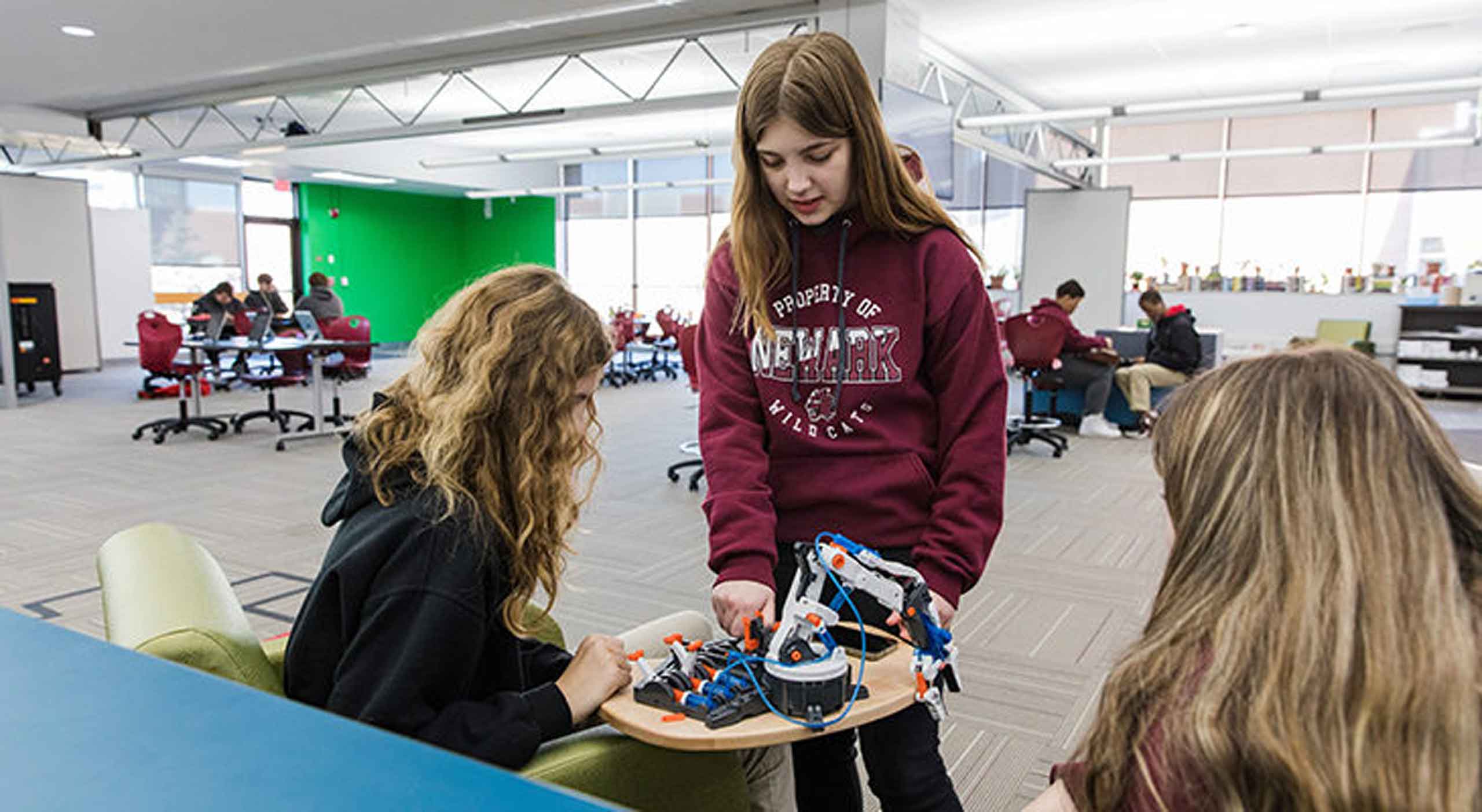
Design minimizes costs to transform Newark High School’s underused library into in-demand Innovation Center and STEM makerspace in less than two months
Last year, residents at the Inn at SharonBrooke in Newark, Ohio were delighted when six Newark High School students, accompanied by Newark City Schools Director of Curriculum and Staff Development Maura Horgan, stopped by to visit and donate birdfeeders. Later, those same students dropped by the Licking County Humane Society to deliver cat toys. What the donated items had in common was that the students had made them in “Do Some Good,” a two-week program held within their school’s Innovation Center.
Making items to donate is just one of many activities happening within the space. The Innovation Center, outfitted with advanced equipment and movable walls, offers students an informal setting—some might call it a hangout—where students build their engineering and artistic skills. Here they tackle STEM challenges in the Engineer Your World class or hone their communications and planning skills in Entrepreneurship class. They build circuits and robots in other programs like “It’s Electric!” or “Code Overload!”
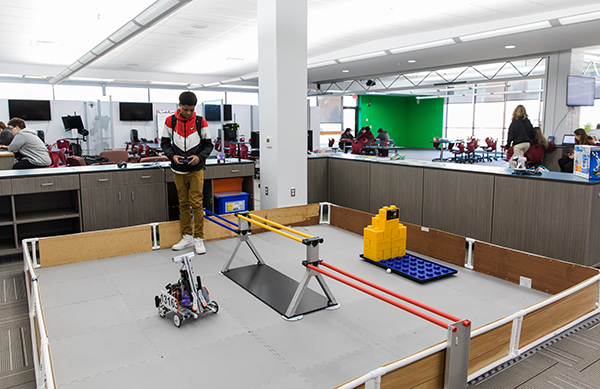
Throughout the day, students drop into the Innovation Center to use equipment ranging from high-tech (e.g., laptops, iPads, VR machine, 3D printer) to no-tech (e.g., sewing machine, Cricut vinyl printing machine, educational game sets). The center even has a green screen for video production projects.
A visitor to this bustling space might have trouble believing that less than two years ago, it was a mostly vacant library and media center.
Horgan said, “We turned an underused area into 21st century spaces with instructional tools, equipment, and materials that provide opportunities for students in ways we were never able to provide before.”
Last school year, staff recorded more than 5,000 student sign-ins to the Innovation Center . . . and that was before COVID-19 forced school closings in March.
The transformation of the 6,100-square-foot Innovation Center, designed by Newark district staff and Legat Architects, occurred gradually. The story of its evolution is one of cooperation, student involvement, and resourcefulness.
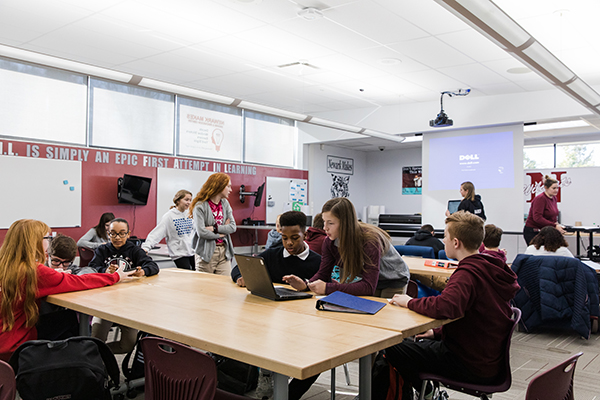
The First Makerspace
The Innovation Center’s origins stretch back to 2016, when laptop carts replaced desktop computers at the high school. This newfound mobility meant that a computer lab in the corner of the library was no longer needed.
Horgan saw it as an opportunity to create a makerspace that encouraged creation and socialization. She tasked a technology integration specialist with researching makerspaces and pitching an idea to transform the underused lab. Consequently, in fall of 2016, the school launched “Newark Makes,” its first official makerspace.
The following year, the library condensed its collections to expand Newark Makes to its current 2,200-square-foot dimensions. The makerspace laid the groundwork for the eventual renovation of the entire library/media center into the Innovation Center.
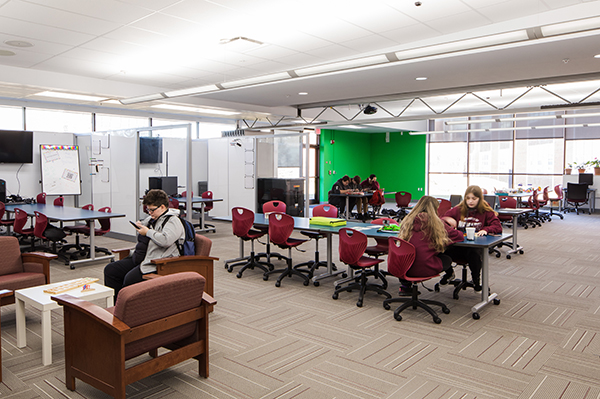
Want to Innovate? Ask Students.
Following the creation of the makerspace, the rest of the library/media center still had plenty of bookstacks and bulky wood furniture. What it did not have was students— the logs showed fewer than 15 books checked out a year . . . and some of those books were checked out by the same students! Most of the students the library/media center did see were those who walked through it to get to the makerspace.
Horgan said, “The library/media center needed to be repurposed to make it a place where students wanted to be, a 21st-century space that provided them with opportunities to collaborate and innovate.”
To gather ideas, Newark City Schools turned to its students—at the start of the 2018 spring semester, Horgan and her team issued an Innovation Center design challenge to high school students and to students in the district’s three middle schools. Those who submitted entries were invited to discussions about how the center should look and what resources it should offer. Each group used a different color masking tape to demarcate its ideas on the floor, then the groups created a final proposal.
Horgan and her team took to heart the students’ suggestions. She said, “Their comments helped us decide how to draw students into the space, as well as what tools and tasks would best enrich their education.”
The administrative and maintenance teams used the student input to “map out” their vision of the space.
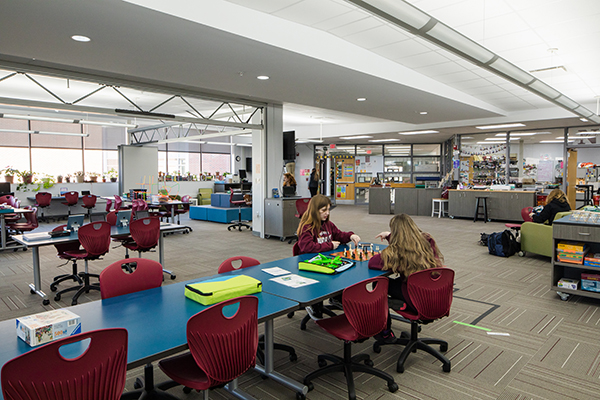
Fast, Cost Effective, and Flexible
In February 2019, the district handed over its plan to Legat, which had already designed more than 300,000 square feet of additions and renovations at the school. This project presented two key challenges: first, the district wanted it completed by the start of the 2019-2020 school year, and second, the district lacked the budget for a full-scale gut and rehab.
Legat project manager Dennis Paben focused on tweaking district ideas with minimal intrusion to the existing space. He assembled furniture provider LOTH and operable partition manufacturer Hufcor to do measuring and layout verification over spring break in March 2019.
Because the school needed to continue using the space for the rest of the school year, the time available for construction was severely reduced. That June, old furniture and equipment was moved out. That gave installers two months to complete the project before school resumed. The renovation retained most of the existing lights, ceiling, and carpeting to reduce costs and speed up construction, which finished in less than two months.
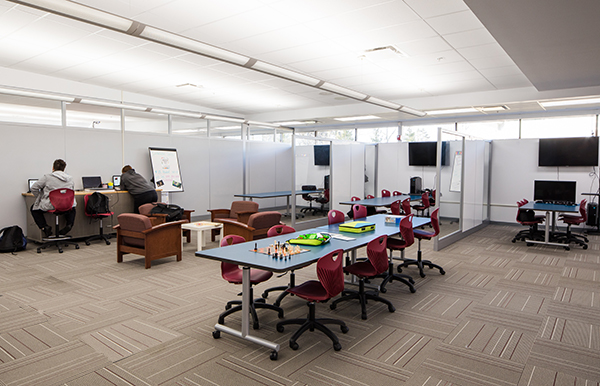
The district wanted the space to be as flexible as possible to accommodate large and small groups, as well as individuals. The solution is evident in the zigzags just below the ceiling in certain parts of the room. These are part of the self-supporting structure of the new operable walls that were installed. They can be opened to create one large space or closed to create different zones. Paben also specified “furniture walls,” which can easily be taken down and rebuilt.
He said, “Traditional walls and doors wouldn’t have fit the budget and would have taken more than a year to build, plus they would have taken away from the open feel of the space.”
Horgan added, “What was once an open area that only allowed for one event at a time, regardless of the group’s size, can now become a more functional space that hosts meetings, classes, and other events in four closed-off spaces.”
And what about the library? According to Horgan, students are now checking out more books than ever thanks to an innovative partnership with the Licking County Library. Once a month, the Licking County Book Mobile visits the high school. Through the partnership, students checked out more items last year than they did from the school’s old library/media center over at least five years.
Licking County Library’s TechSperts also come to the Innovation Center to present to ninth graders monthly. They do everything from showing students how to use free online apps to giving Book-Talks of newly released young adult novels and series.
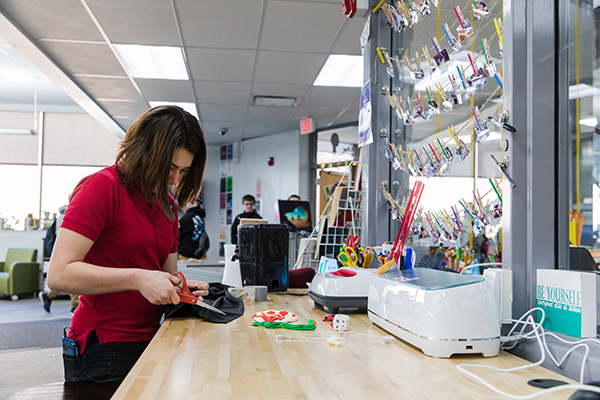
A Place of Belonging
21st Century Learning Coach Alison Charpie, who coordinates the Innovation Center’s two-week themed programs, said that many students are now “regulars” in the space. “Many students tell me that the Innovation Center is a place where they feel comfortable being themselves. They have the ability to get involved with a lot more activities that they didn’t think would be available to them at a high school.”
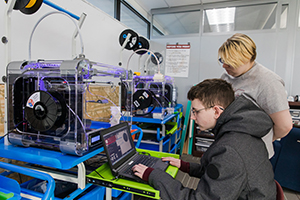
Before the coronavirus forced school closings, 23 students had joined the Innovation Center Club, which meets monthly to discuss social media promotions, upcoming programs, and service opportunities around Licking County.
“I’ve noticed a new sense of belonging and ownership with many of the students that use the Innovation Center,” said Charpie. “Whether they’re cracking codes, inventing machines, or taking apart clocks, they are building skills that will give them a jump-start for their careers.”
Contact us to learn more about educational design or comment below to share your thoughts on this post.


